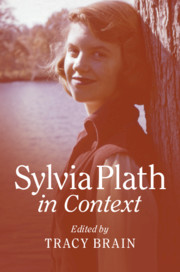Book contents
- Sylvia Plath in Context
- Sylvia Plath in Context
- Copyright page
- Contents
- Notes on Contributors
- Acknowledgements
- Chronology
- Abbreviations and Textual Note
- Key Archives
- Introduction
- Part I Literary Contexts
- Part II Literary Technique and Influence
- Part III Cultural Contexts
- Part IV Sexual and Gender Contexts
- Part V Political and Religious Contexts
- Part VI Biographical Contexts
- Chapter 23 Plath’s Journals
- Chapter 24 Plath’s Teaching and the Shaping of Her Work
- Chapter 25 Electroshock Therapy and Plath’s Convulsive Poetics
- Chapter 26 Plath’s Scrapbooks
- Chapter 27 Beyond Letters Home: Plath’s Unabridged Correspondence
- Part VII Plath and Place
- Part VIII The Creative Afterlife
- Bibliography
- Index
Chapter 25 - Electroshock Therapy and Plath’s Convulsive Poetics
from Part VI - Biographical Contexts
Published online by Cambridge University Press: 03 August 2019
- Sylvia Plath in Context
- Sylvia Plath in Context
- Copyright page
- Contents
- Notes on Contributors
- Acknowledgements
- Chronology
- Abbreviations and Textual Note
- Key Archives
- Introduction
- Part I Literary Contexts
- Part II Literary Technique and Influence
- Part III Cultural Contexts
- Part IV Sexual and Gender Contexts
- Part V Political and Religious Contexts
- Part VI Biographical Contexts
- Chapter 23 Plath’s Journals
- Chapter 24 Plath’s Teaching and the Shaping of Her Work
- Chapter 25 Electroshock Therapy and Plath’s Convulsive Poetics
- Chapter 26 Plath’s Scrapbooks
- Chapter 27 Beyond Letters Home: Plath’s Unabridged Correspondence
- Part VII Plath and Place
- Part VIII The Creative Afterlife
- Bibliography
- Index
Summary
Anita Helle provides transdisciplinary perspectives on electroshock therapy as a context for Plath’s fiction. Counter to many critics and biographers, Helle does not ‘diagnose’ Plath. Rather, she historicises Plath’s literary response to an electroshock treatment from both sides of a highly mobile, linguistically multi-valent, and ideologically charged literary and medical spectrum. Plath’s literary responses to electric shock treatment emerge in the context of post-WWII social upheavals. In these, representations of ECT in art and literature recall surrealist aims to shape a counter-aesthetic “convulsive beauty” in response to collective threat.
Keywords
- Type
- Chapter
- Information
- Sylvia Plath in Context , pp. 264 - 274Publisher: Cambridge University PressPrint publication year: 2019

